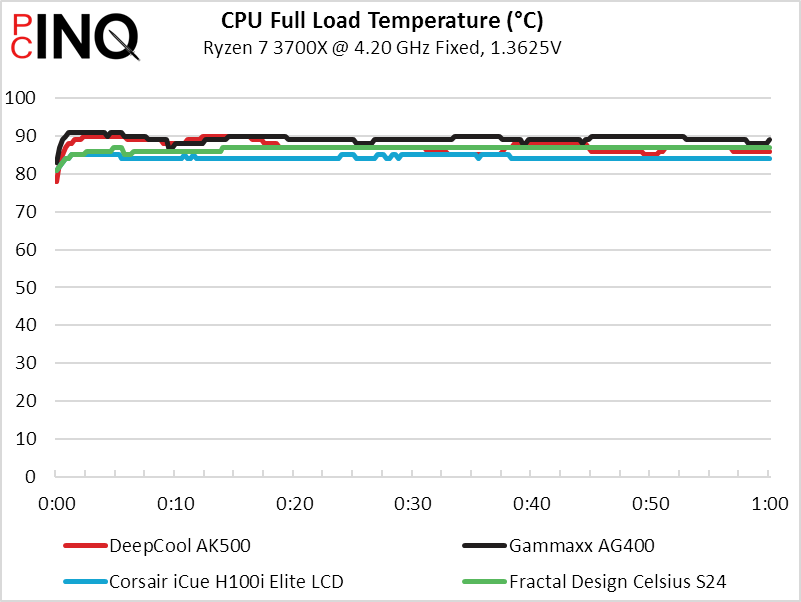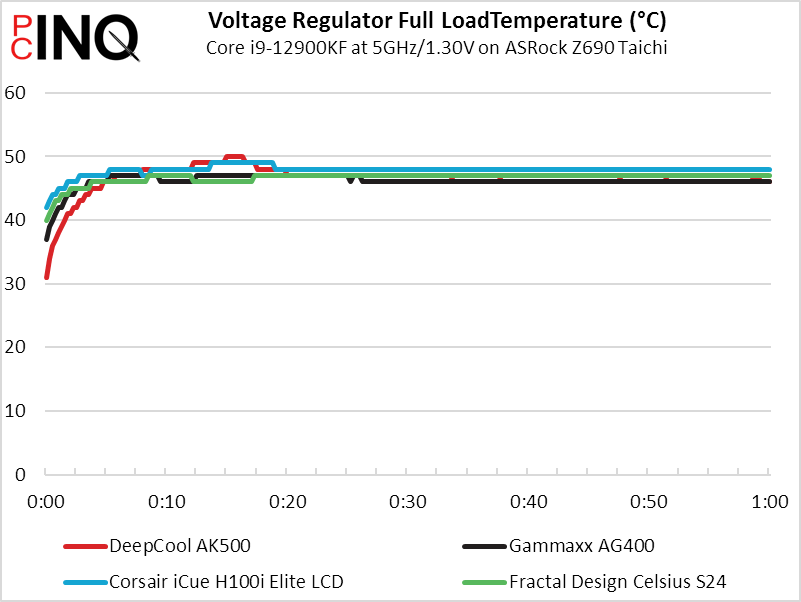DeepCool AK500 Big Air CPU Cooler Review
Comparing DeepCool’s AK500 to its recently reviewed Gammaxx sibling is a matter of proportion: With twice the heat sink size and weight, the AK500 could offer up to twice the cooling capacity if only its single-fan could take on the extra load. This is normally where dual-fan twin-tower heat sinks come into play, but there’s still something to be said for having one giant block of fins. Maybe it’s that a single fan is quieter than two, or that the warm air at the back of the sink is still cooler than the surrounding metal when operating under the most dire of conditions, but a single fan that’s powerful enough to move air through a sink this large while operating slowly enough not to disturb us with noise just seems…efficient.
| DeepCool AK500 | |||
| Type | Cross Draft Single Tower | Offsets | 48mm rearward (22mm w/fan) |
| CPU Support | LGA 2066/2011/1700/1200/115x, AM5/4 | Fan Size | 120mm x 25mm |
| Height/Width/Depth | 158mm / 127mm / 117mm | Connectors | (1) PWM |
| Base Height | 44mm | Weight | 1019g (36oz) |
Get it at Amazon

(click for availability)

Regardless of how much more capacious we expect the AK500 to be than its AG400 sibling, the fact that Deepcool includes LGA 2066 mounting hardware only with this larger part speaks volumes about its expectations. Other upgrades include a set of clips for mounting a second cooling fan to the back, a larger syringe of thermal compound, a long L-shaped #2 Phillips screwdriver and a resistor wire that could be used to slow the fan speed when using the cooler on a motherboard that doesn’t support fan control. Then again, a motherboard so cheap that it doesn’t support PWM fan control and a $55+ cooler seem so unlikely a pairing that we consider the resistor cable superfluous.

The AK500’s base is smoothed a bit more than the typical direct-contact design by adding a soldered-on copper base plate. The AK500 further differentiates itself from the AG400 in its 48mm rearward offset, which is reduced to 22mm when we add the thickness of a single fan to its front.

One thing that DeepCool isn’t telling anyone is that its AM5/AM4 mounting brackets are also AM3 compatible, and that’s probably because the firm doesn’t include the differently-threaded standoffs needed to secure these brackets to those antiquated boards. The AM5/AM4 standoffs include a plastic spacer on one side to protect the motherboard’s surface: Two brackets top the standoffs, regardless of whether the standoffs are AM5/AM4, LGA2066/LGA2011, or LGA 1700/1200/115x.

The top of the heat sink features a snap off cover that reveals an access hole for the rear mounting screw.

Remembering that the square hole just behind the middle of the heat sink aligns with one of the two factory-installed mounting screws, it makes sense that DeepCool choose to include so long a screwdriver with this cooler. At least we get a good look at the front screw when the fan is removed.

Add the cover and fan, and we’re ready to run our test. But first, a look at how this appears through the side window of our case.

Those who want “more look” will likely add a lighted fan, but we’re fine with the blacked-out appearance of the AK500’s stock part.
| System Configuration | |
| Case | Cooler Master MasterBox TD500 Mesh |
| CPU | AMD Ryzen 7 3700X: 8 cores/ 16 threads, 32MB L3 Cache O/C to 4.20 GHz (42x 100 MHz) at 1.3625 V Core |
| Motherboard | MSI X570 Ace: AMD X570, Socket AM4 |
| RAM | T-Force Vulcan Z TLZGD416G3200HC16CDC0 DDR4-3200 |
| Graphics | Gigabyte GeForce RTX 2070 Gaming OC 8G: GeForce RTX 2070 1815 MHz GPU, GDDR6-14000, Maximum Fan When Listed |
| Hard Drives | Toshiba OCZ RD400 256GB NVMe SSD |
| Sound | Integrated HD Audio |
| Network | Integrated Gigabit Networking |
| Power | Cooler Master XG 750 Plus Plantinum: Fully modular, 80Plus Platinum |
| Test Configuration | |
| Load Software | Prime95 Version 30.7 Torture Test, Small FFTs |
| H/W Monitoring | HWiNFO64 v6.28-4200 |
| SPL Monitoring | Galaxy CM-140 SPL Meter: Tested at 1/4 m, corrected to 1 m (-12 dB) |
To simplify the discussion, the AK500 is around half a degree less effective at cooling than the warmest liquid cooler in our chart and nearly two degrees cooler than the AG400, on average. That makes it the best air cooler to be tested in this system.

It unfortunately gets buried under the other cooler results, but the AK500 eventually cooled our motherboard’s voltage regulator to the same temperature as the AG400, beating both liquid coolers in its ability to push air over that portion of our motherboard.

Still far from silent, the AK500 still surprised us by being the quietest cooler in the group. By the numbers shown on our meter, we’d need two of its fans just to create a similar level of noise to the next-quietest cooler of the group.

We modified the scale on today’s cooling-to-noise chart to make the lowest temperature and highest noise level 100%, which in turn shows that the AK500 produces 94% the cooling at only 83% the noise of the most powerful cooler tested in this machine.

Since decibels are on a logarithmic scale, the blue line in the above chart isn’t the most accurate scale even though the concept of lesser and greater still apply. That its to say, the AK500 still has the best ratio of temperature to noise.
| DeepCool AK500 | |
| Pros: | Cons: |
|
|
| The Verdict: | |
| The AK500 provides nearly as much cooling as a compact liquid cooler, for nearly as much money. | |
Get it at Amazon

(click for availability)
The problem is that it’s also expensive: We recently awarded the AG400 for its value, and we’re having a hard time saying that the AK500 is worth nearly three times its price. One of our favorite air coolers before such considerations, we’ll leave judgments about the AK500’s worth to its buyers.
